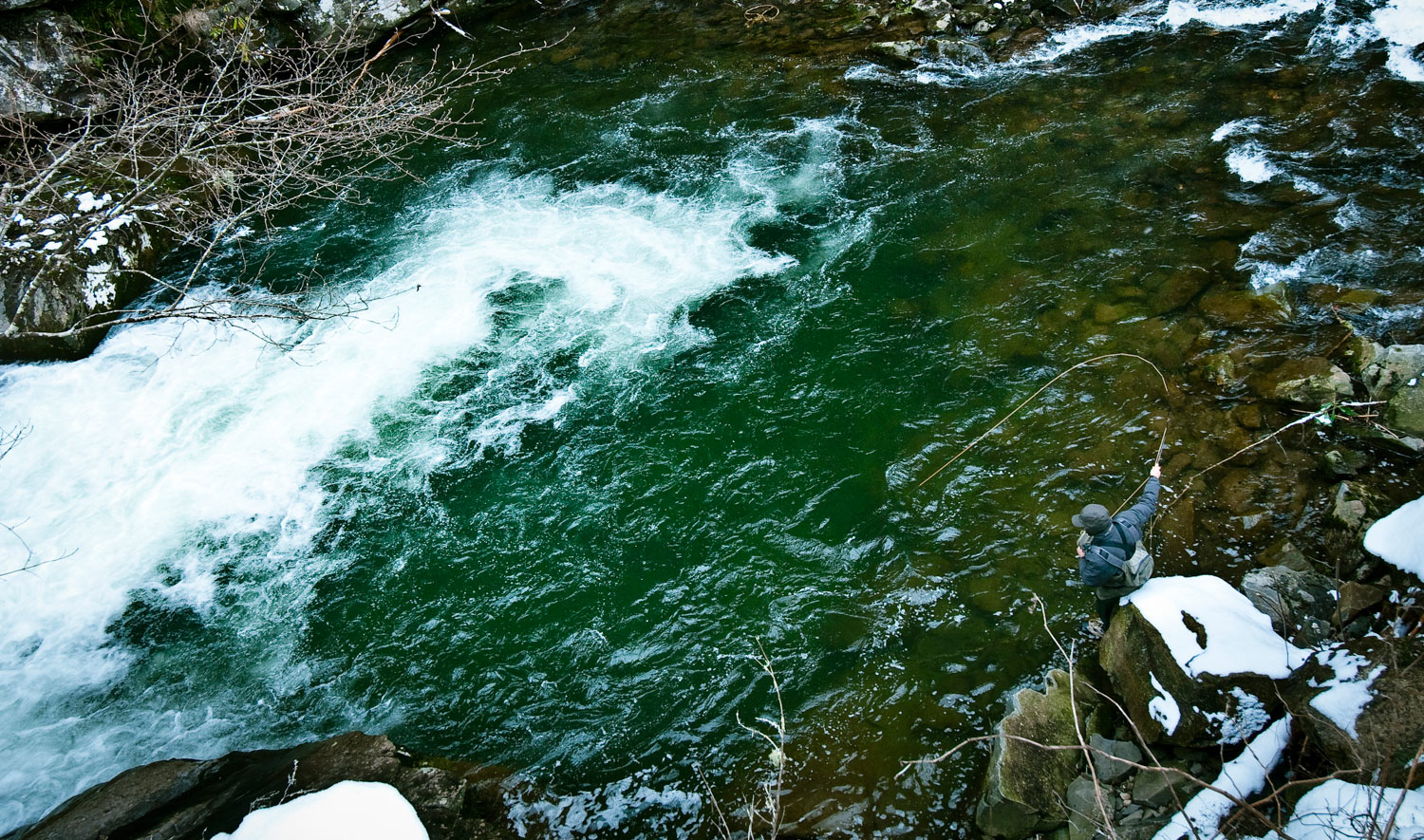By Kyle Wilkinson
If the arrival of winter does not signal an end to your fishing, chances are good you’re going to be spending some time on a tailwater in the months to come.
While the issue of dams and rivers is clearly a topic for another day, the fact remains that dams have created some pretty incredible wintertime trout playgrounds for those willing to endure frozen fingers and guides. Aside from the fact that tailwater fisheries are known to grow incredibly large, in most places they are also known to grow incredibly intelligent trout. The reasons for this are two-fold. 1) The fish have a TON of natural food for them due to the consistent water temps and flows created by said dam. 2) Tailwaters typically receive quite a bit of angling pressure and as such, most of the trout swimming here are going to have a PhD in spotting a poor drift. Does this mean then that catching a tailwater trout or two should be a bonus, while heading home with a skunk on your back should be the norm? Absolutely not! Remember, big trout have to eat all the time to maintain their size and as such, are going to remain very catchable as long as we put the odds in our favor.
Here are four tips that I religiously live by when fishing for tailwater trout. If you don’t already, put these to use next time you hit the water and I think you’ll be pleasantly delighted with the results.
1. Tighten Up Flies. This is a big one for me and is something I promise will help put fish in the net. Do this: hold your hand out in front of you and make a fist. Now extend your thumb and pinky out in opposite directions. That distance between your two digits is the spacing to use for your flies. Depending on the size of your hands, you’re probably looking at 8-10” and this is perfect! I’m well aware this will seem very strange if you’re used to fishing your flies 18” apart (like I see people doing all the time out on the water) but I encourage you to give it a try. Remember, a tailwater trout -–particularly in the winter–is rarely going to chase down a meal. Giving that fish as many options as possible directly in front of their face is going to increase your chances of catching it dramatically!
 Use Split Shot AND Putty. This is another non-negotiable for me on the technical tailwaters of Colorado. When rigging up in the morning, I’ll place one split shot 8-10” above my first fly– usually somewhere between a size 2-4. After this, I will use tungsten putty to make all my additional weight adjustments throughout the day. Using this type of putty couldn’t be easier and allows me to dial in my weight to a much greater degree than I could by pinching multiple split shots on and off my tippet throughout the day. When I come to a location that requires more weight, I’ll simply pinch off a bit of putty, flatten it between my thumb an index finger, and then roll directly on top of my split shot. Make a nice round ball and you’ll be good to go. If I realize the putty I added was either too much or too little, simple pinching a little back off or adding a bit more is all it takes. At the end of the day, remove the putty from your split shot and place back in the container to be used another day. It doesn’t get any easier than that!
Use Split Shot AND Putty. This is another non-negotiable for me on the technical tailwaters of Colorado. When rigging up in the morning, I’ll place one split shot 8-10” above my first fly– usually somewhere between a size 2-4. After this, I will use tungsten putty to make all my additional weight adjustments throughout the day. Using this type of putty couldn’t be easier and allows me to dial in my weight to a much greater degree than I could by pinching multiple split shots on and off my tippet throughout the day. When I come to a location that requires more weight, I’ll simply pinch off a bit of putty, flatten it between my thumb an index finger, and then roll directly on top of my split shot. Make a nice round ball and you’ll be good to go. If I realize the putty I added was either too much or too little, simple pinching a little back off or adding a bit more is all it takes. At the end of the day, remove the putty from your split shot and place back in the container to be used another day. It doesn’t get any easier than that!
Use Yarn Indicators. If it’s winter and I’m fishing anything that could be described as ‘technical’ you can bet I’m using a yarn indicator. I like both the New Zealand style, as well as the type with the little rubber o-rings that you attach like a thingamabobber. Whichever you prefer, there is no indicator in existence that will give you the sensitivity of yarn. As I mentioned in tip #1, tailwater fish aren’t typically going to attack your fly, particularly in winter. Oftentimes your indicator may only pause, twitch, “lean over” for a moment, etc. Yarn also lands much softer on the water than a plastic bubble-type indicator and won’t leave a ring of waves racing away in all directions. This fact alone will add considerable stealth to your approach- particularly when sight fishing to a fish in shallow water. Yes, yarn indicators do require a little maintenance throughout the day in the form of drying them off and adding some fly floatant, however I’ve never had an issue with doing this because I know it means I’ll be putting more fish in the net throughout the day.
Build A Tailwater Leader. After years of fishing tailwaters, this is something I really only started doing a of couple years ago. However, it is a trick that I know is making me a better angler. Here’s how I do it. Buy a 7.5 ft 5x leader and then chop it in half. Next, tie a perfection loop into the butt section. Follow this up by tying a perfection loop into an 18” piece of 2x fluorocarbon tippet. Attach these two loops together with a loop-to-loop connection. All that’s left to do now is build your leader down with consecutive pieces of fluorocarbon tippet, i.e., 3x to 4x to 5x, etc. I attach each new piece of tippet with a blood knot. I like my tailwater leaders to be about 10’ long to my first fly. Depending on the size of tippet you’ll be using, some quick math will let you know how long each piece of tippet should be as you build your leader down. As a general rule though, a couple of feet of each size should get you in the ballpark. Building your leader in the manner described above will cut through the water (and get your flies into the zone) much quicker than with a traditional tapered leader. Additionally, the butt section you cut in half during step one will be reusable for months!
Use these 4 tips next time you head to your favorite tailwater and your catch rates are bound to go up!
Kyle Wilkinson Gink & Gasoline www.ginkandgasoline.com hookups@ginkandgasoline.com Sign Up For Our Weekly Newsletter!



Great suggestion with the “finger to thumb” measuring stick. I’ve always tied my second fly on 12 to 18 inches behind. Fishing the tailwaters of White in AR next month and I’ll be sure to use this.
Thanks, it’s nice to read something that goes against the grain! I will try running flies that close next time out. I already do all the other stuff!
Interesting, I will give em a try on the Cumberland (Ky) and south holston (TN). we really only have tail water for big trout in KY
Stoked to try the putty on the shot next time
Kyle,
Not sure with all the weight that you are suggesting that building a new leader is all that critical to cutting thru the water.The weight itself is enough to do the trick especially if you increase by a couple of feet or so where your fly lands in the water to give it more contact time in the water to sink to its desired level.Sometimes it’s better to keep it simple in the freezing cold and adjust your cast and weight only.Starting there for me helps to eliminate all the knot tying especially when I break off more than one section on a snag.I know what you are saying but lots of time my hands don’t get the message.Practicality is trumping adaptability!!!!
If I fish flies closer than about 12″ apart, I get a lot of foul hooked fish.
Kyle,
Same tips for spring creeks in winter?
FYI, Hobby Lobby sells tungsten putty for pine wood derby cars. $10.95. Excited to try that out, thanks for the tip.
Pingback: Tippets: Interview with Lori-Ann Murphy, Building a Nymphing Leader, Tailwater Trout | MidCurrent